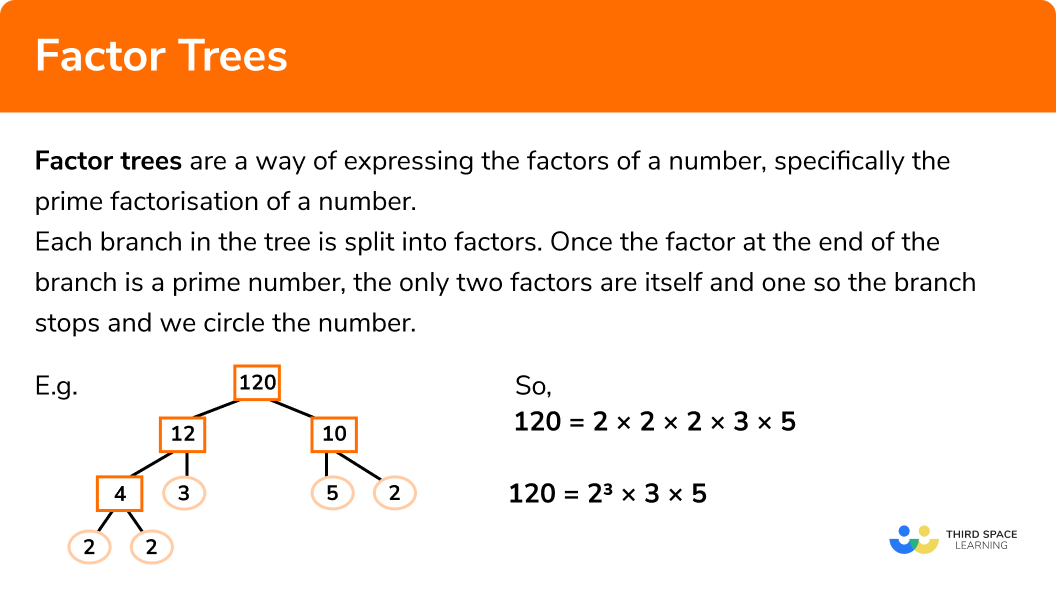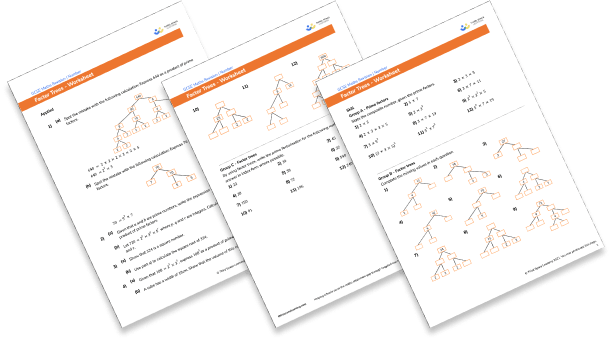prime numbers in relation to drawing trees
One to one maths interventions built for KS4 success
Weekly online one to one GCSE maths revision lessons now available
Learn more
This topic is relevant for:

Factor Trees
Here we will learn about about factor trees including how to construct factor trees and use them in a variety of contexts.
There are also factor trees worksheets based on Edexcel, AQA and OCR exam questions, along with further guidance on where to go next if you're still stuck.
What are factor trees?
Factor trees are a way of expressing the factors of a number, specifically the prime factorization of a number.
Each branch in the tree is split into factors. Once the factor at the end of the branch is a prime number, the only two factors are itself and one so the branch stops and we circle the number.
We also must remember that
Factor trees can be used to:
- find the highest common factor (HCF),
- find the lowest common multiple (LCM) (sometimes called the least common multiple)
- find other numerical properties such as whether a number is square, cube or prime
We can convert different quantities to whole numbers (kilograms to grams for example) to avoid working with decimals.
A factor tree does not contain decimals as we are working with positive factors (natural numbers).
What are factor trees?

Prime factor trees
In order to produce a prime factor tree we need to be able to recall the prime numbers between
These prime numbers are:
\[2, 3, 5, 7, 11, 13, 17, 19\]
Let's have a look at an example:
E.g.
Use a factor tree to write 51 as a product prime factors
We split the original number 51 into two branches by writing a pair of factors at the end of the branch,
As 3 × 17 = 51, one branch will end in a 3, the other in 17.
Both the numbers
Now there is a prime number at the end of each branch we have constructed a prime factor tree.
If the numbers were not primes then we would continue to split them into factors until there was a prime number at the end of each branch.
We can now write
\[51 = 3 × 17\]
Top tip: write the prime factors in order, smallest to largest.
The factor trees of a number are not unique, but the product of prime factors is unique.
This means that a number could have multiple different factor trees that will all give the same product of prime factors.
Writing an answer in index form
We when write a number as a product of its prime factors we should write it in index form.
E.g.
Express the number
So,
\[24 = 2 × 2 × 2 × 3\]
We can write this in index form:
\[24 = 2^3 × 3\]
By using an alternative pair of factors for
So,
\[24 = 2 × 2 × 2 × 3\]
We can write this in index form:
\[24 = 2^3 × 3\]
How to use a factor tree
In order to use a factor tree:
- Write the number at the top of the factor tree and draw two branches below
- Fill in the branches with a factor pair of the number above
- Continue until each branch ends in a prime number
- Write the solution as a separate line of working (in index form if required)
Explain how to use a factor tree for prime factorisation in 4 steps


Factor trees worksheet

Get your free factor trees worksheet of 20+ questions and answers. Includes reasoning and applied questions.
DOWNLOAD FREE

Factor trees worksheet

Get your free factor trees worksheet of 20+ questions and answers. Includes reasoning and applied questions.
DOWNLOAD FREE
Factor tree examples
Example 1: standard problem
Express the number
- Write the number at the top of the factor tree and draw two branches below
Here we write
2 Fill in the branches with a factor pair of the number above
The number
3 Continue until each branch ends in a prime number
Both the numbers
Here we have highlighted the numbers
We now have each branch ending in a prime number and so this factor tree is now complete.
4 Write the solution as a separate line of working (in index form if required).
Select each prime number and express them as a product (multiply them):
\[120 = 2 × 2 × 2 × 3 × 5\]
Written in index form:
\[120 = 2^3 × 3 × 5\]
Full solution:
\[120 = 2^3 × 3 × 5\]
Example 2: index from
The number
Write the number at the top of the factor tree and draw two branches below
Fill in the branches with a factor pair of the number above
Continue until each branch ends in a prime number
Write the solution as a separate line of working (in index form if required)
\begin{aligned} &242 = 2 × 11 × 11 \\\\ &242 = 2 × 11^2 \\\\ &a = 2, \; b=11 \end{aligned}
Example 3: unique factor tree
Complete the diagram to show the prime factor decomposition of the missing number in index form.
Write the number at the top of the factor tree and draw two branches below
The number at the top of the tree is the product of the branches below. This means that the number we are expressing is equal to:
\[5 × 20 = 100\]
Fill in the branches with a factor pair of the number above
Looking further down the diagram, we can see that the number
is split into two factors. One of those factors is equal to
therefore the other factor must be:
\[20 ÷ 5 = 4\]
Continue until each branch ends in a prime number
The only factor pair of
Write the solution as a separate line of working (in index form if required)
Here we are finding the product of prime factors of
, so:
\begin{aligned} 100 &= 2 × 2 × 5 × 5\\\\ 100 &= 2^2 × 5^2 \end{aligned}
Full solution:
\[100 = 2^2 × 5^2\]
The factor tree in this question is unique because it was already partially completed.
Example 4: multiple steps
Given that
Write the number at the top of the factor tree and draw two branches below
Fill in the branches with a factor pair of the number above
Here, the question has given us a headstart as the factor pair we can use for
Continue until each branch ends in a prime number
Write the solution as a separate line of working (in index form if required)
\[72 = 2 × 2 × 2 × 3 × 3\]
\[72 = 2^3 × 3^2\]
Full solution:
\[72 = 2^3 × 3^2\]
Example 5: powers of 2
Express the number
Write the number at the top of the factor tree and draw two branches below
Fill in the branches with a factor pair of the number above
Continue until each branch ends in a prime number
Keep going…
Nearly there…
One more step…
Great! We got there!
Write the solution as a separate line of working (in index form if required)
\begin{aligned} &64 = 2 × 2 × 2 × 2 × 2 × 2 \\\\ &64 = 2^6 \end{aligned}
Here are two alternatives to the same factor tree:
Version 1
Version 2
Example 6: algebraic prime factorisation
Let
Write the number at the top of the factor tree and draw two branches below
Fill in the branches with a factor pair of the number above
Continue until each branch ends in a prime number
Write the solution as a separate line of working (in index form if required)
\[21x^2 = 3 × 7 × x × x\]
Common misconceptions
- Using addition instead of multiplication
E.g.
When creating a factor tree for say
- Assuming a number is prime
There are several numbers which are frequently misused as a prime number, here are a few of them:
They are usually a multiple of
- Not writing the final solution
After completing the factor tree, you must write the number as a product of its factors, otherwise you have demonstrated a method but not answered the question (such as using grid multiplication and not adding up the values in the grid for your final solution).
- Incorrect simplifying of solution
Once you have reached a prime number in the factor tree, highlight it, otherwise it can get lost in the complexity of the factor tree.
Space out the diagram so you can clearly see all the factors and circle the prime factors for your solution. Then carefully check how many of each prime number exist, then write the solution using index form. The order of the product of prime factors does not matter but the numbers do!
Practice factor tree questions



1 \times 2^{2} \times 5 \times 7

140 = 2 \times 2 \times 5 \times 7
140 = 2^2 \times 5 \times 7


2^{3} \times 3^{2} \times 5^{3}

2 \times 3 \times 5 \times 11

330 = 2 \times 3 \times 5 \times 11




84 = 2 \times 2 \times 3 \times 7
84 = 2^2 \times 3 \times 7
a=2, \;b=3, \;c=7
196 should be split into 2 and 98

14 should be split into 2 and 7

7 should be split into 1 and 7

There is no mistake – the solution is correct

14=7 \times2 so 14 should be split into 2 and 7 . The tree should look like this:
196 = 7 \times 2 \times 7 \times 2
196 = 2^2 \times 7^2
( 196 could be split into 2 and 98 but 14 and 14 is also correct)




243 = 3 \times 3 \times 3 \times 3 \times 3
243 = 3^5
35 \times a \times a \times b

5 \times 5 \times a \times b

5 \times 7 \times a \times a \times b \times b

5 \times 7 \times a \times a \times b

35a^2b = 5 \times 7 \times a \times a \times b
Remember: when we write algebraic expressions, we write numbers and then letters in alphabetical order.
Factor trees GCSE questions
1. Using 36 = 2^{2} \times 3^{2} state the prime factor decomposition of 720 . Show all your working.
(5 Marks)
Show answer
720 = 36 × 20 (could be shown in the factor tree)
(1)
(1)
(1)
720 = 2^{2} \times 3^{2} \times 2 \times 2 \times 5
(1)
720 = 2^{4} \times 3^{2} \times 5
(1)
2. (a) Express 900 as a product of prime factors in index form.
(b) Use part (a) to show that 900 is a square number.
(5 Marks)
Show answer
(a)
(factorises two numbers correctly)
(1)
(complete factorisation)
(1)
900 = 2^{2} \times 3^{2} \times 5^{2}
(1)
(b)
900=(2 \times 3 \times 5)^{2}
(1)
\begin{aligned} 900=30^{2} \\\\ \sqrt{900}=30 \end{aligned}
(1)
3. Simplify fully \sqrt{180}
(4 Marks)
Show answer
(1)
180=2^{2}\times3^{2}\times5
(1)
\sqrt{180}=2 \times 3 \times \sqrt{5}
(1)
\sqrt{180}=6\sqrt{5}
(1)
Learning checklist
You have now learned how to:
- use the concepts and vocabulary of prime numbers, factors (or divisors), prime factorisation, including using product notation and the unique factorisation property.
Still stuck?
Prepare your KS4 students for maths GCSEs success with Third Space Learning. Weekly online one to one GCSE maths revision lessons delivered by expert maths tutors.

Find out more about our GCSE maths revision programme.
We use essential and non-essential cookies to improve the experience on our website. Please read our Cookies Policy for information on how we use cookies and how to manage or change your cookie settings.Accept
Source: https://thirdspacelearning.com/gcse-maths/number/factor-tree/
0 Response to "prime numbers in relation to drawing trees"
Post a Comment